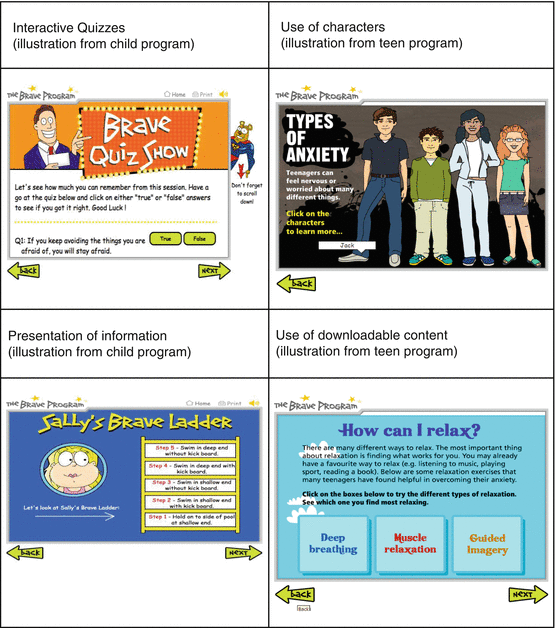
Fig. 11.1
Examples of strategies used in BRAVE-ONLINE
Client Satisfaction
In terms of client satisfaction, evaluations of BRAVE have shown that it is perceived favorably by children, adolescents, and parents, who endorse the online format as an appealing and convenient mode of treatment delivery. The program has now demonstrated efficacy across a number of trials, as outlined above, with rates of improvement similar to face-to-face CBT by follow-up. BRAVE appears to offer a viable, evidence-based alternative for those families unable or unwilling to attend traditional therapy, although it is a time-intensive program that requires some therapist support.
Recent Developments with Brave
In addition to the RCTs described above demonstrating the significant benefits of the BRAVE program with children and adolescents, Donovan and March (2014) amended the parent program and evaluated its efficacy in a sample of parents of preschool aged children (3–5 years) with anxiety disorders. Results revealed significant improvements in child anxiety compared to waitlist participants and highlight the potential for variants of the program to be utilized with different age groups. The BRAVE program, as an intervention that takes a transdiagnostic approach to anxiety, is also currently being compared to a newly developed, social phobia-specific version of the program in an RCT with children and adolescents experiencing social anxiety. A UK-based study is also in progress that examines the role of the parent BRAVE program in an adolescent sample. Further, it is being examined in a community effectiveness trial in a New Zealand sample following the Christchurch earthquakes. A self-help version of the program has been developed and is currently being disseminated to Australian young people.
The BarnInternetprojektet (BiP)
(Translated as the Stockholm Child Internet Project) focuses on developing and evaluating ICBT for children with anxiety disorders (Vigerland et al. 2013), ICBT for adolescents with obsessive-compulsive disorder (OCD) (Lenhard et al. 2014) or non-suicidal self-injury (NSSI), and ICBT for children and adolescents with functional gastrointestinal disorder (FGID) (Bonnert et al. 2014).
General Description of the BiP Programs
All BiP programs can be thought of as an interactive e-learning system with therapist support. The aim of the treatment is to teach participants techniques for overcoming their problems and the material is presented in short slides containing a limited amount of information that the participants work through.
Participants have access to the treatment platform for 10–12 weeks. Throughout the treatment, participants have contact with a therapist, mostly through written messages within the platform but also, if needed, over the telephone. Telephone calls are often limited to 1–2 calls and reasons for calling could, for example, be that the participant is lagging behind treatment or need extra support with exposure exercises.
All current BiP interventions typically contain information about the disorder, the rational for treatment, goal setting, foreseeing and managing obstacles, problem solving, planning of exposure exercises, and relapse prevention. The content of the treatments is presented in a varied manner with reading material, films, animations, illustrations, and exercises aimed at consolidating knowledge, practicing new skills, relating personally to the content, or increasing interactivity.
All exercises are saved in an accessible way in the treatment platform so that it is easy for the participants to go back and revise their answers. They also receive comments and feedback from their therapist on all exercises and the technical platform also allows participants to comment on worksheets. Hence, conversations about particularly important worksheets, such as treatment goals or exposure hierarchy, are easily accessible. It is important to note that the communication does not have to be, and seldom is, synchronous. The participants can send written messages to their therapist at any time during treatment. Therapists have the possibility to comment on worksheets or reply to messages at any time but typically log in every weekday. Therapists provide feedback, prompts, and encouragement. All participants have their own assigned therapist throughout the treatment.
Adapting the Program for Different Age Groups
There are some differences in the treatment for children (8–12 years), compared to the treatment for adolescents (13–17 years). For children, the parents are highly involved in the treatment and are responsible for conducting the treatment together with the child. Some parts are directed only to parents where they receive information and instructions on how to help their child in the best way. In the parts that are directed to the child and their parents, less written material and more animations are used to explain the concepts of fear, anxiety, exposure, etc.
In the adolescent programs, the parents and adolescents complete separate content and work more independently. Parents access the same psycho-education and rationale for treatment as their adolescents but are also given exercises on how to be supportive of their adolescent during the program without necessarily being directly involved.
Animated psycho-education about feelings directed at children | Psycho-education about coping strategies and an audio file with a breathing exercise |
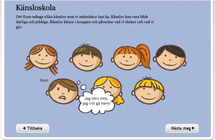 |  |
Whiteboard animation of psycho-education about OCD | Downloadable material |
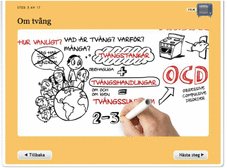 | 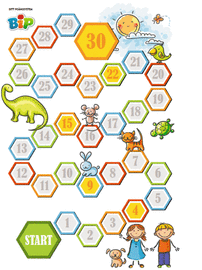 |
Goal ladder | Drag and drop exercise |
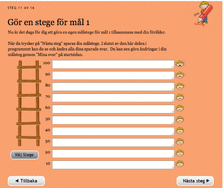 | 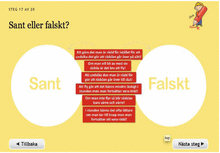 |
Recent and Future Developments with BiP
To date, three pilot studies and one RCT have been completed, with three RCTs currently in progress. A smart phone application has recently been developed that is used in conjunction with ICBT to facilitate compliance with homework assignments, as well as for collecting more detailed data on treatment activity and progress.
Discussion
Clinical Issues and Challenges in Implementation of ICBT for Children
There are numerous clinical issues and implementation challenges that have been reported or are potentially of importance for ICBT interventions for children. While families who are motivated, engaged, and compliant and appear to respond well to ICBT, there are some families who fail to respond in the same manner. Similar to ICBT interventions delivered with adults, the loss of face-to-face contact with a therapist in combination with inflexible (manualized) programs is likely to pose a number of clinical challenges for children, parents, and clinicians. First, some families fail to complete all ICBT sessions (or progress much slower than in face-to-face therapy), even with therapist prompting via e-mail or telephone. It seems likely that for some, set appointment times and expectations from a “real” therapist may be vital to enhancing and maintaining motivation and compliance. The evidence to date suggests that compliance with ICBT interventions is of importance in predicting outcome for youth, although more so with adolescents rather than children (e.g., Anderson et al. 2012). Second, there is less capacity to support the child or parent when they experience difficulties in knowledge/skill acquisition or in the application of strategies to real-life situations. Third, there are reduced opportunities to encourage generalization beyond the specific target of the intervention and assist the client to apply the learned skills to comorbid or other more complex difficulties (or common child–parent relationship problems). Although there is reduced capacity to tailor interventions to the client’s needs or preferences, this is less likely to be a problem in ICBT interventions for children (as opposed to adults), due to the tendency for youth-based programs to focus on common transdiagnostic elements of CBT that relate to multiple disorders.
Of course, some of these challenges can potentially be offset in interactive programs that include therapist support components. Interestingly, despite the loss of face-to-face contact, studies have shown that a therapeutic alliance can be established in computer interventions where there is some therapist contact, even when only via e-mail (Anderson et al. 2012; Khanna and Kendall 2010), and that stronger alliance is associated with better outcomes for ICBT, at least for adolescents (Anderson et al. 2012). Therefore, clinical challenges due to the loss of real-time therapist involvement are likely to be more evident in programs that do not include therapist contact.
While it seems feasible to transfer CBT content into online packages, clinicians and researchers should be aware of the clinical challenges that accompany such ICBT interventions. There are likely to be some children and families for whom ICBT is less suited, and future research needs to identify the specific challenges and circumstances under which ICBT is most effective for the various disorders, in order to inform clinical practice.
Dissemination and Cost-Effectiveness
Despite the growing evidence base for ICBT interventions for children and adolescents, there have been very few systematic attempts to examine models of dissemination or evaluate cost-effectiveness in this group. Although individual researchers have estimated the potential time or cost savings of their interventions (March et al. 2009; Spence et al. 2011), with respect to ICBT treatment programs, we are yet to conduct comprehensive cost-effectiveness evaluations. There is much room for further research into these issues in ICBT programs for children. Emerging findings in the adult literature demonstrate the cost-effectiveness of ICBT for depression and anxiety (Hedman et al. 2011; McCrone et al. 2004), with one study showing greater cost savings for ICBT compared to group CBT (Hedman et al. 2011).
Encouragingly, ICBT programs for childhood emotional and behavioral disorders have been generally well accepted by users, although sometimes with slightly lower satisfaction ratings given by parents (March et al. 2009; Spence et al. 2011). Unfortunately, less is known about the acceptability of Internet-based treatments by the general population and whether families would be likely to participate in interventions delivered through population-wide dissemination attempts.
While there is potential to widely disseminate ICBT programs to increase access to evidence-based treatment and provide cost-effective alternatives to face-to-face therapy, this is not achievable until we understand clearly for whom child ICBT interventions are best suited. ICBT interventions will be most cost-effective and dissemination models most effective if directed at appropriate targets. It is particularly important to prevent programs from being disseminated to the “wrong” populations: those likely to experience treatment failure and who subsequently may be unwilling to attempt CBT, ICBT, or any therapy in the future.
The purpose or objective of dissemination must also first be determined. For example, if the goal of dissemination is to enhance access to quality, gold-standard treatments for childhood emotional and behavioral disorders, then dissemination is likely to require therapist involvement and potentially lower cost savings. However, if the goal of dissemination is to provide access to lower-intensity interventions that act as a first step in a stepped-care approach, then dissemination may have a broader scope and potentially lower costs (although perhaps may not greatly reduce the impact of existing disorders). “Open access” programs are easier to disseminate (free and no participation restrictions), but also typically do not include validated diagnostic procedures and support and are not as suitable for “clinical”-level difficulties. However, they have the potential benefit of providing prevention or early intervention effects and may possibly improve acceptability of ICBT or therapy in general.
If ICBT programs are to be disseminated with the support of a therapist, it also raises the question of who is required to deliver the intervention. Fortunately, there is emerging research from the adult and child literature that demonstrates that support provided by nonprofessionals (e.g., technicians) or professionals not trained in CBT can be as beneficial as support provided by specialist CBT professionals or psychologists (Khanna and Kendall 2010; Robinson et al. 2010; Titov et al. 2010). This makes sense given that for the majority of Internet-based CBT packages, the core CBT components are built into the program and supported through multimedia mechanisms and interactive activities. Thus, specialized skills are not required from the support person and this means that dissemination models may be able to utilize nonspecialized support persons in treatment delivery (thus reducing costs further). This holds particular potential for child-based interventions as children are frequently in contact with various professionals (e.g., teachers, nurses, school counselors), all who could potentially play a role in the dissemination of ICBT programs. However, the effects of ICBT when delivered by specialist and nonspecialist support persons are yet to be determined for various child emotional and behavioral problems.
Thus, acceptability of ICBT by the general population, information about who is most suited to these interventions, and desired outcomes of dissemination models must first be determined to ensure successful and cost-effective methods for dissemination. Even if ICBT interventions are efficacious, there are still critical elements of clinical practice that are not suitable to Internet-based delivery with children (e.g., diagnosis for some childhood disorders, suicide risk assessment, family conflict) and these factors must be considered in dissemination attempts.
Stay updated, free articles. Join our Telegram channel

Full access? Get Clinical Tree





